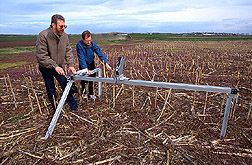This page has been archived and is being provided for reference purposes only. The page is no longer being updated, and therefore, links on the page may be invalid.
|
Read: a report on the scanners in Agricultural Research magazine. |
High-Tech Scanners Ease Methods for Erosion ControlBy Linda McGrawJuly 7, 2000 Can a change in farming practices help reduce car accidents? Agricultural Research Service scientists in Manhattan, Kan., think so. Each year, several serious multi-car accidents are caused by high winds blowing topsoil across highways, according to ARS agricultural engineers Larry Wagner and Fred Fox. Standing crop residue can be 10 times more effective in reducing wind erosion than flat residue in erosion, prone areas of the west, midwest, and northern and southern plains. Erosion causes the loss of more than 2 billion tons of soil from U.S. cropland each year, and wind erosion accounts for 45 percent of this loss. Excessive erosion triggers worries about sediments, nutrients and pesticides affecting water quality, as well as concerns about air quality and traffic visibility. To guard against erosion, Wagner and Fox designed a lightweight, portable scanner that can be used by farmers, crop consultants and USDA Natural Resources Conservation Service employees to measure standing crop residue. Old ways of measuring standing crop residue were tedious and labor-intensive. Fox reported preliminary results of laboratory tests today at the International Soil Tillage Research Conference in Ft. Worth, Texas. The scanner was modeled after a laser scanner developed by ARS soil scientist Chi-hua Huang at the National Soil Erosion Research Laboratory in W. Lafayette, Ind. Huang’s original scanner is used around the world by soil scientists in Australia, Austria, China and Germany. But he improved on the design, resulting in a scanner that is 100 times faster than the original. ARS is the chief scientific research agency for the U.S. Department of Agriculture. A full report on the versatility of the scanners can be found in the July issue of Agricultural Research. Scientific contacts: Larry Wagner or Fred Fox, ARS Wind Erosion Research Unit, Kansas State University, Manhattan, Kan.; phone (785) 532-6807 [Wagner] and (785) 532-6694 [Fox]; fax (785) 532-6528; wagner@weru.ksu.edu, fredfox@weru.ksu.edu. |

